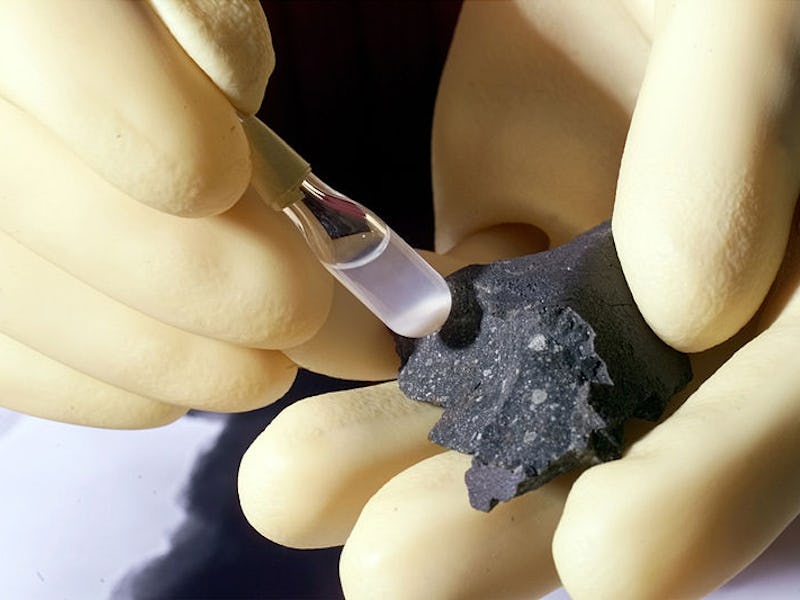Oldest material ever discovered on Earth found in Australian meteorite
7 billion-year-old stardust has been hidden inside this unremarkable space rock for over 60 years.

The Earth is routinely hit by rocks traveling through interstellar space, offering hints as to the origins of life — and everything else — in the universe. These hints come in the form of stardust encased in meteorites — traces of elements left over from ancient supernova, the explosions that mark the death of stars. In fact, nearly all of the elements found in our bodies originated in these violent, ancient stellar explosions.
Now, scientists have discovered grains of stardust in a meteorite that date back 5 to 7 billion years ago — before the Solar System was even created. These tiny grains are the oldest solid material ever found on Earth, providing scientists with rare clues about stellar formation during the early history of our universe.
Scientists detail the discovery in a paper published this week in the journal Proceedings of the National Academy of Science. Remarkably, the find comes from a meteorite that fell to Earth some 60 years ago — rhe Murchison meteorite.
With a mass of around 220 pounds, the rock landed near Murchison, Victoria in Australia in 1969. It was first observed in the sky as a massive fireball, which then disintegrated into three fragments, and ultimately crash-landed on Earth.
The meteorite is relatively well-studied, but it is due to recent advances in technology that scientists are only now discovering what is perhaps the meteorite’s precious cargo.
Unpacking the Murchison meteorite
Meteorites are fragments of comets or asteroids that journey through outer space, before piercing through Earth’s atmosphere and falling onto our planet. Because they are made of the same rocky material that formed other planetary bodies in the universe, meteorites provide many clues about the history of the cosmos and are within our physical reach.
Scientists have used this particular meteorite to uncover the secrets of the cosmos for decades, as the Murchison contains large amounts of organic compounds.
The team of scientists isolated presolar grains from fragments of the meteorite.
Around 30 years ago, presolar grains — minerals that formed before the Solar System — were collected from the meteorite at the University of Chicago. To get at the grains, scientists essentially crushed fragments of the meteorite into a powder, which they then form into a sort of paste.
“Once all the pieces are segregated, it’s a kind of paste, and it has a pungent characteristic-it smells like rotten peanut butter,” Jennika Greer, a graduate student at the Field Museum and the University of Chicago and co-author of the study, said in a statement.
The paste is then dissolved with acid — a process only the presolar grains can survive.
By measuring the amount of cosmic rays these grains have been exposed to, scientists could then put a date on when they formed.
The stardust in the Murchison meteorite dates to before our Solar System was formed.
Cosmic rays are high-energy particles emitted from stars and galaxies, constantly moving through space at the speed of light. As stardust is exposed to cosmic rays, they interact and form new elements. The more elements found in stardust, then the longer it has been exposed to cosmic rays — and the older it is.
“I compare this with putting out a bucket in a rainstorm,” Philipp Heck, associate professor at the University of Chicago, and lead author of the study, said in a statement. “Assuming the rainfall is constant, the amount of water that accumulates in the bucket tells you how long it was exposed.”
The data reveal that most of the stardust in the meteorite formed 4.6 to 4.9 billion years ago, with some dating back to 5.5 billion years. Past research has uncovered grains that date back just 4.5 billion years.
The finding not only marks the oldest solid material ever found, but also contradicts a popular theory about how star formation in the Milky Way takes place.
The data suggest a period of enhanced star formation some 7 billion years ago — disputing the idea that star formation happens at a steady rate in our galaxy.
“We have more young grains that we expected,” Heck said. “Our hypothesis is that the majority of those grains, which are 4.9 to 4.6 billion years old, formed in an episode of enhanced star formation. There was a time before the start of the Solar System when more stars formed than normal.”
The team hope that other researchers use their data to create models of stellar life-cycles in the Milky Way — essentially creating a timeline of the life of our galaxy.